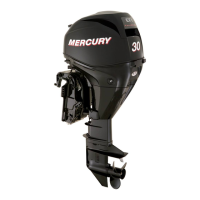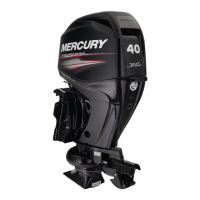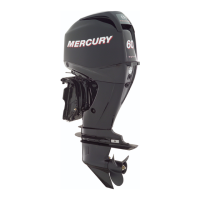General Information
Page 1C-8 90-8M0065421 NOVEMBER 2012
• Propeller pitch too high: engine RPM below recommended maximum range
• Lean fuel mixture at, or near, wide‑open throttle
• Spark plugs: heat range too hot, incorrect reach, cross‑firing
• Deteriorated or inadequate engine cooling system
• Combustion chamber deposits: result in higher compression ratio
Detonation usually can be prevented if:
• The engine is correctly set up
• Regular maintenance is scheduled
Propeller Selection
IMPORTANT: The engines covered in this manual are equipped with an RPM rev‑limiter that is set to an upper RPM limit. This
limit, which is slightly above the normal operating range of the engine, helps prevent damage from excessive engine RPM.
Once the RPM returns to the recommended operating RPM range, normal engine operation resumes.
The boat manufacturer and the selling dealer are responsible for equipping the power package with the correct propeller. Refer
to Mercury Marine's web page http://www.mercurymarine.com for information.
Select a propeller that will allow the engine power package to operate at or near the top end of the recommended WOT
operating RPM range with a normal load.
If full‑throttle operation is below the recommended range, the propeller must be changed to prevent loss of performance and
possible engine damage. On the other hand, operating an engine above the recommended operating RPM range will cause
higher than normal wear and damage.
After initial propeller selection, the following common problems may require that the propeller be changed to a lower pitch.
• Warmer weather and greater humidity cause a loss of RPM.
• Operating in a higher elevation causes a loss of RPM.
• Operating with a dirty boat bottom causes a loss of RPM.
• Operating with increased load (additional passengers, pulling skiers) causes a loss of RPM.
For better acceleration, such as is needed for waterskiing, use the next lower pitch propeller. When not pulling skiers, do not
operate at full throttle when using the lower pitch propeller.
Following Complete Submersion
Engine Submerged While Running (Special Instructions)
When an engine is submerged while running, the possibility of internal engine damage is greatly increased. After the engine is
recovered, remove the spark plugs. If the engine fails to turn over freely when turning the flywheel, the possibility of internal
damage (bent connecting rod and/or bent crankshaft) exists. The powerhead must be disassembled for inspection.
Saltwater Submersion (Special Instructions)
Due to the corrosive effect of saltwater on internal engine components, complete disassembly of the engine is necessary
before any attempt is made to start the engine.
Fresh Water Submersion (Special Instructions)
1. Recover the engine as quickly as possible.
2. Remove the cowling.
3. Flush the exterior of the outboard with fresh water to remove mud, weeds, etc. Do not attempt to start the engine if sand
has entered the powerhead. Disassemble the powerhead if necessary to clean the components.
4. Remove the spark plug and get as much water as possible out of the powerhead. Most of the water can be eliminated with
portable engines by placing the engine in a horizontal position (with spark plug hole down) and rotating the flywheel.
5. Turn the engine over and pour alcohol into the spark plug opening and rotate the flywheel.
6. Again turn the engine over and pour approximately one teaspoon of engine oil into the spark plug opening. Rotate the
flywheel to distribute the oil in the cylinder.
7. Dry all of the wiring and electrical components using compressed air.
8. Reinstall the spark plug.
9. Change the engine oil.
10. Attempt to start the engine using a fresh fuel source. If the engine starts, run the outboard for a short time and check for
the presence of water in the oil. If water is present, the oil will appear milky. Drain and replace the oil as previously
mentioned. If no water is present, restart the engine and run it for at least one hour to eliminate any water in the engine.

